实验7:基于REST API的SDN北向应用实践
实验7:基于REST API的SDN北向应用实践
基本要求
- 编写Python程序,调用OpenDaylight的北向接口实现以下功能
- (1) 利用Mininet平台搭建下图所示网络拓扑,并连接OpenDaylight;
![]()
- (2) 下发指令删除s1上的流表数据。
ODLDelete.py#!/usr/bin/python import requests from requests.auth import HTTPBasicAuth if __name__ == "__main__": url = 'http://127.0.0.1:8181/restconf/config/opendaylight-inventory:nodes/node/openflow:1/' headers = {'Content-Type': 'application/json'} res = requests.delete(url, headers=headers, auth=HTTPBasicAuth('admin', 'admin')) print (res.content) - (3) 下发硬超时流表,实现拓扑内主机h1和h3网络中断20s。
ODLTimeOut.py
ODLTimeOut.jsonimport requests from requests.auth import HTTPBasicAuth if __name__ == "__main__": url = 'http://127.0.0.1:8181/restconf/config/opendaylight-inventory:nodes/node/openflow:1/flow-node-inventory:table/0/flow/1' with open("./ODLTimeOut.json") as f: jstr = f.read() headers = {'Content-Type': 'application/json'} res = requests.put(url, jstr, headers=headers, auth=HTTPBasicAuth('admin', 'admin')) print (res.content){ "flow": [ { "id": "1", "match": { "in-port": "1", "ethernet-match": { "ethernet-type": { "type": "0x0800" } }, "ipv4-destination": "10.0.0.3/32" }, "instructions": { "instruction": [ { "order": "0", "apply-actions": { "action": [ { "order": "0", "drop-action": {} } ] } } ] }, "flow-name": "flow1", "priority": "65535", "hard-timeout": "20", "cookie": "2", "table_id": "0" } ] }![]()
- (4) 获取s1上活动的流表数。
ODLGetFlow.py#!/usr/bin/python import requests from requests.auth import HTTPBasicAuth if __name__ == "__main__": url = 'http://127.0.0.1:8181/restconf/operational/opendaylight-inventory:nodes/node/openflow:1/flow-node-inventory:table/0/opendaylight-flow-table-statistics:flow-table-statistics' headers = {'Content-Type': 'application/json'} res = requests.get(url,headers=headers, auth=HTTPBasicAuth('admin', 'admin')) print (res.content)![]()
- 编写Python程序,调用Ryu的北向接口实现以下功能
- (1) 实现上述OpenDaylight实验拓扑上相同的硬超时流表下发。
RyuTimeOut.py
RyuTimeOut.json#!/usr/bin/python import requests if __name__ == "__main__": url = 'http://127.0.0.1:8080/stats/flowentry/add' with open("./RyuTimeOut.json") as f: jstr = f.read() headers = {'Content-Type': 'application/json'} res = requests.post(url, jstr, headers=headers) print (res.content){ "dpid": 1, "cookie": 1, "cookie_mask": 1, "table_id": 0, "hard_timeout": 20, "priority": 65535, "flags": 1, "match":{ "in_port":1, }, "actions":[ ] }![]()
- (2) 参考Ryu REST API的文档,基于VLAN实验的网络拓扑,编程实现相同的VLAN配置。
Topo.py
RyuVlan.py#Topo.py:建立要求的拓扑 from mininet.topo import Topo class MyTopo(Topo): def __init__(self): # initilaize topology Topo.__init__(self) self.addSwitch("s1") self.addSwitch("s2") self.addHost("h1") self.addHost("h2") self.addHost("h3") self.addHost("h4") self.addLink("s1", "h1") self.addLink("s1", "h2") self.addLink("s2", "h3") self.addLink("s2", "h4") self.addLink("s1", "s2") topos = {'mytopo': (lambda: MyTopo())}import json import requests if __name__ == "__main__": url = 'http://127.0.0.1:8080/stats/flowentry/add' headers = {'Content-Type': 'application/json'} flow1 = { "dpid": 1, "priority": 1, "match":{ "in_port": 1 }, "actions":[ { "type": "PUSH_VLAN", "ethertype": 33024 }, { "type": "SET_FIELD", "field": "vlan_vid", "value": 4096 }, { "type": "OUTPUT", "port": 3 } ] } flow2 = { "dpid": 1, "priority": 1, "match":{ "in_port": 2 }, "actions":[ { "type": "PUSH_VLAN", "ethertype": 33024 }, { "type": "SET_FIELD", "field": "vlan_vid", "value": 4097 }, { "type": "OUTPUT", "port": 3 } ] } flow3 = { "dpid": 1, "priority": 1, "match":{ "vlan_vid": 0 }, "actions":[ { "type": "POP_VLAN", "ethertype": 33024 }, { "type": "OUTPUT", "port": 1 } ] } flow4 = { "dpid": 1, "priority": 1, "match": { "vlan_vid": 1 }, "actions": [ { "type": "POP_VLAN", "ethertype": 33024 }, { "type": "OUTPUT", "port": 2 } ] } flow5 = { "dpid": 2, "priority": 1, "match": { "in_port": 1 }, "actions": [ { "type": "PUSH_VLAN", "ethertype": 33024 }, { "type": "SET_FIELD", "field": "vlan_vid", "value": 4096 }, { "type": "OUTPUT", "port": 3 } ] } flow6 = { "dpid": 2, "priority": 1, "match": { "in_port": 2 }, "actions": [ { "type": "PUSH_VLAN", "ethertype": 33024 }, { "type": "SET_FIELD", "field": "vlan_vid", "value": 4097 }, { "type": "OUTPUT", "port": 3 } ] } flow7 = { "dpid": 2, "priority": 1, "match": { "vlan_vid": 0 }, "actions": [ { "type": "POP_VLAN", "ethertype": 33024 }, { "type": "OUTPUT", "port": 1 } ] } flow8 = { "dpid": 2, "priority": 1, "match": { "vlan_vid": 1 }, "actions": [ { "type": "POP_VLAN", "ethertype": 33024 }, { "type": "OUTPUT", "port": 2 } ] } res1 = requests.post(url, json.dumps(flow1), headers=headers) res2 = requests.post(url, json.dumps(flow2), headers=headers) res3 = requests.post(url, json.dumps(flow3), headers=headers) res4 = requests.post(url, json.dumps(flow4), headers=headers) res5 = requests.post(url, json.dumps(flow5), headers=headers) res6 = requests.post(url, json.dumps(flow6), headers=headers) res7 = requests.post(url, json.dumps(flow7), headers=headers) res8 = requests.post(url, json.dumps(flow8), headers=headers)![]()
进阶要求
- GetNode.py
import requests import time import re class GetNodes: def __init__(self, ip): self.ip = ip def get_switch_id(self): url = 'http://' + self.ip + '/stats/switches' re_switch_id = requests.get(url=url).json() switch_id_hex = [] for i in re_switch_id: switch_id_hex.append(hex(i)) return switch_id_hex def getflow(self): url = 'http://' + self.ip + '/stats/flow/%d' switch_list = self.get_switch_id() ret_flow = [] for switch in switch_list: new_url = format(url % int(switch, 16)) re_switch_flow = requests.get(url=new_url).json() ret_flow.append(re_switch_flow) return ret_flow def show(self): flow_list = self.getflow() for flow in flow_list: for dpid in flow.keys(): dp_id = dpid switchnum= '{1}'.format(hex(int(dp_id)), int(dp_id)) print('s'+switchnum,end = " ") switchnum = int(switchnum) for list_table in flow.values(): for table in list_table: string1 = str(table) if re.search("'dl_vlan': '(.*?)'", string1) is not None: num = re.search("'dl_vlan': '(.*?)'", string1).group(1); if num == '0' and switchnum == 1: print('h1',end = " ") if num == '1' and switchnum == 1: print('h2',end = " ") if num == '0' and switchnum == 2: print('h3',end = " ") if num == '1' and switchnum == 2: print('h4',end = " ") print("") flow_list = self.getflow() for flow in flow_list: for dpid in flow.keys(): dp_id = dpid print('switch_name:s{1}'.format(hex(int(dp_id)), int(dp_id))) for list_table in flow.values(): for table in list_table: print(table) s1 = GetNodes("127.0.0.1:8080") s1.show()![]()
个人总结
- 实验难度:
本次的实验难度难度还蛮大的,但总的来说就是需要参考REST API文档然后用python实现特定的网络功能,修改参数、自我缝合,综合应用。 - 实验过程遇到的困难及解决办法:
- 困难:在搭建好拓扑的时候,发现pingall全都ping不通,curl删除流表以及
sudo mn -c后也无法ping通。 - 解决办法:在分析后得知,应该先开启odl或ryu后,再建立拓扑。
- 困难:运行RyuVlan.py时候发现无效。
- 解决办法:没有打开Ryu,需要输入
ryu-manager ryu.app.simple_switch_13 ryu.app.ofctl_rest打开Ryu,以及建立拓扑的格式sudo mn --custom Topo.py --topo mytopo -- controller=remote,ip=127.0.0.1,port=6653 --switch ovsk,protocols=OpenFlow13。
- 困难:在搭建好拓扑的时候,发现pingall全都ping不通,curl删除流表以及
- 个人感想:
通过本次的实验,我明白了SDN应用层与控制层之间的北向接口REST API。重新回顾PDF文档熟悉了相关控制器的使用,对控制器的启动,下发流表等操作更熟悉了,并且在实践中通过阅读相关文档,查阅资料,了解到了北向接口API其实并没有一个统一的标准,不同的控制器对应着的API也有所区别,体会到了SDN框架的灵活性和可编程性。

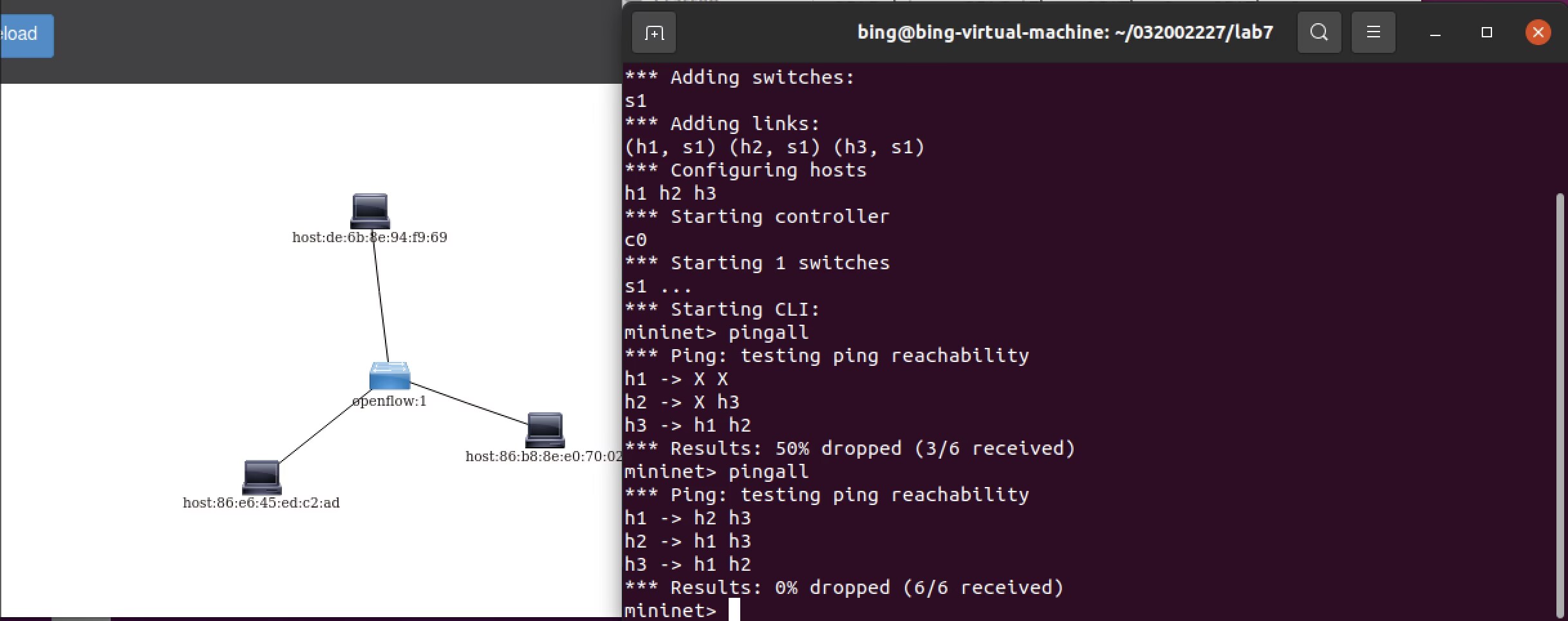

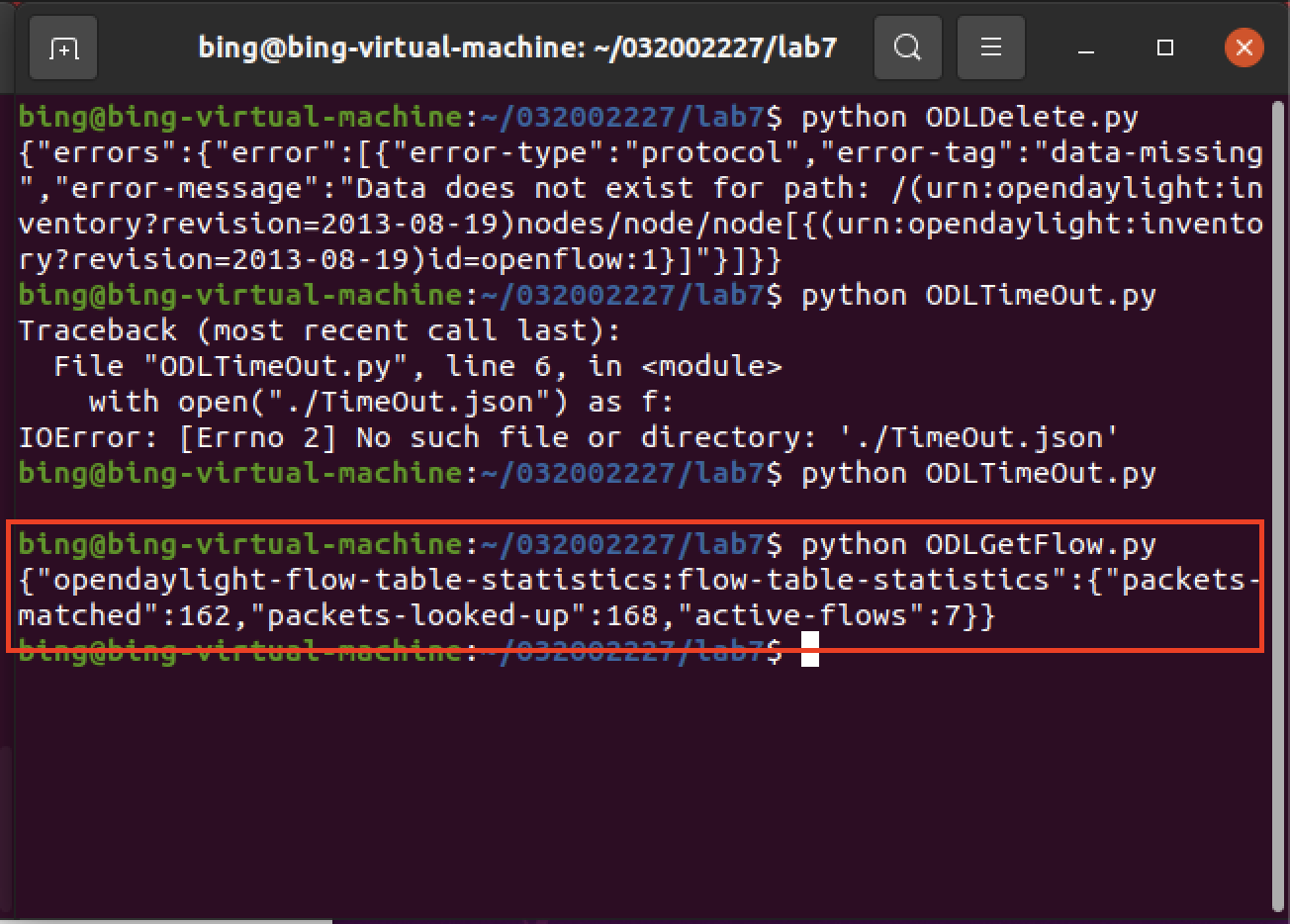
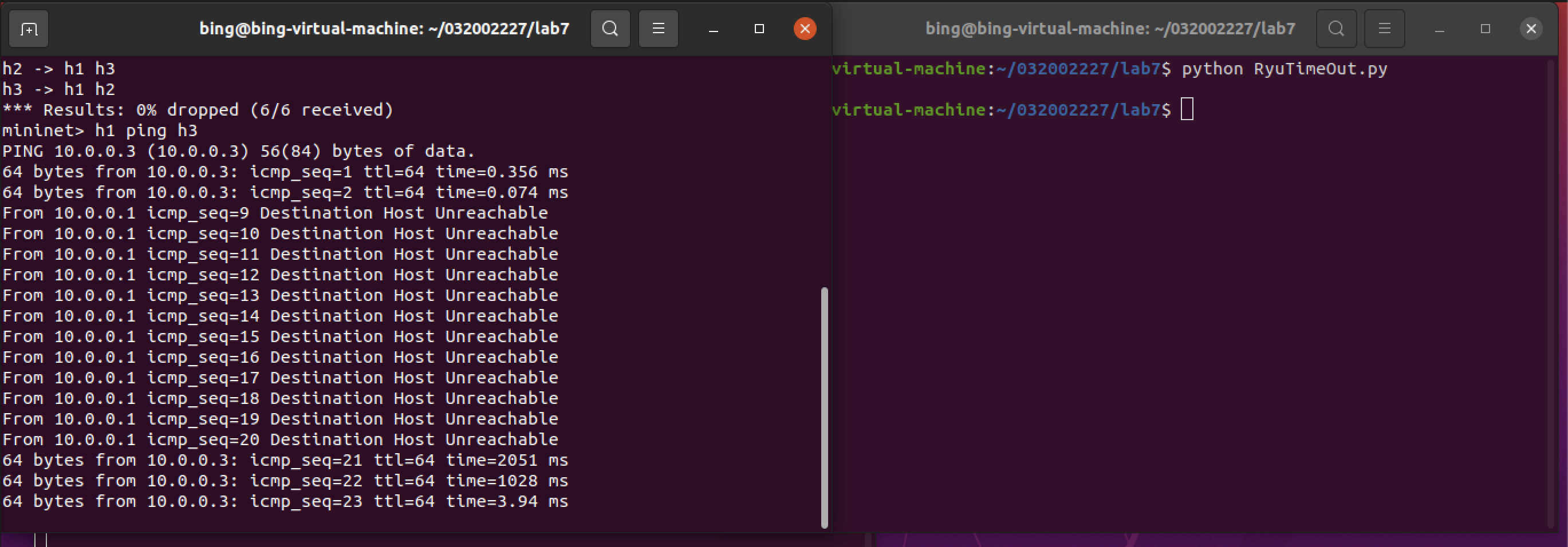
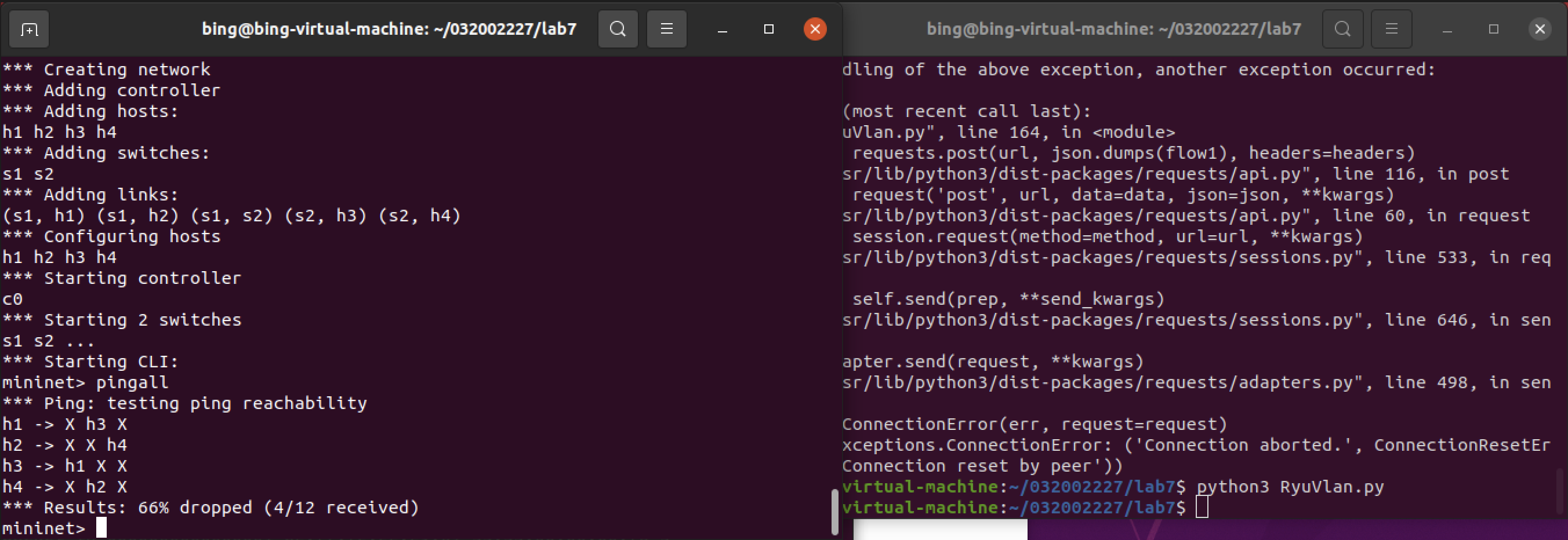
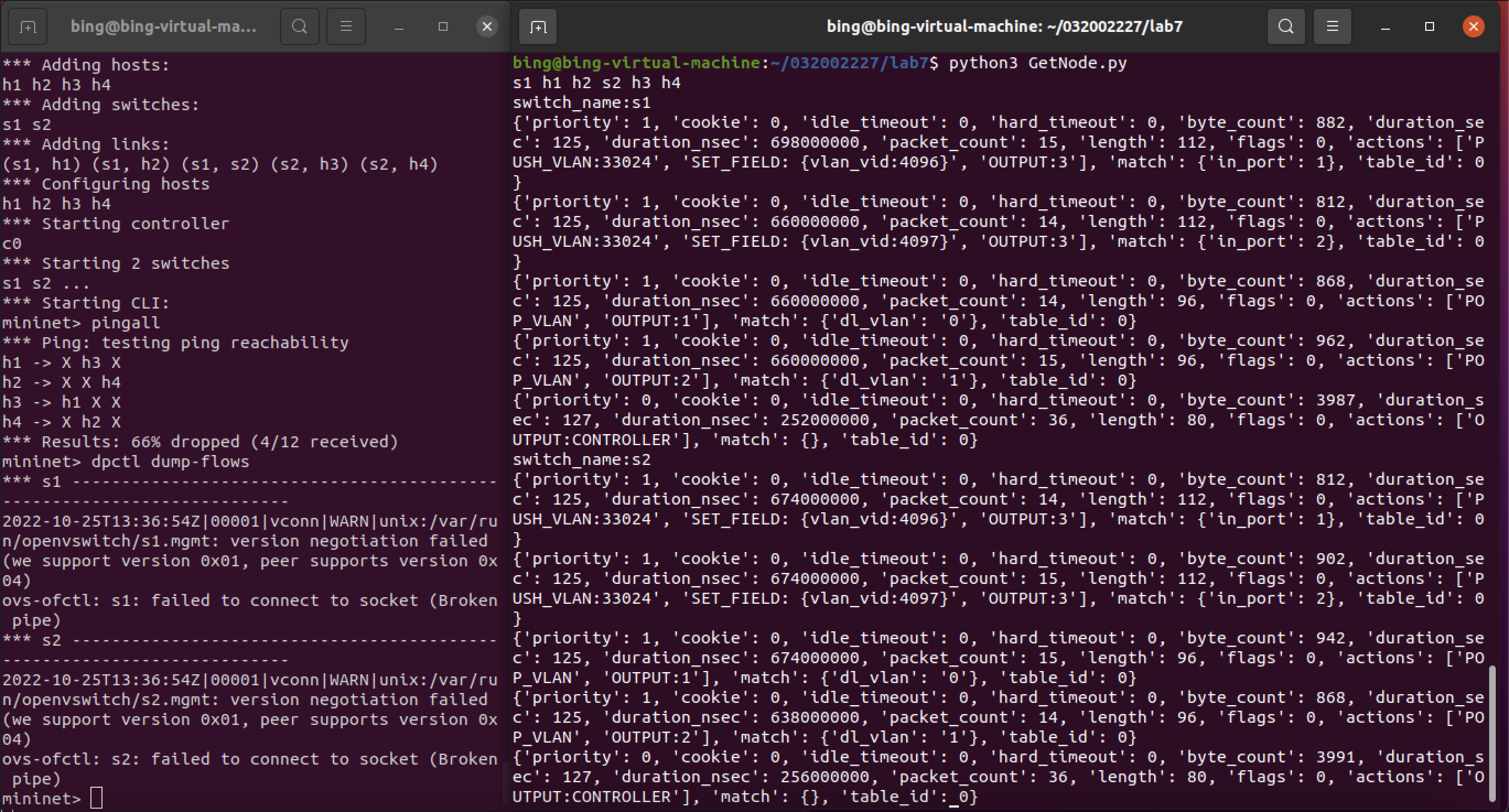

 浙公网安备 33010602011771号
浙公网安备 33010602011771号